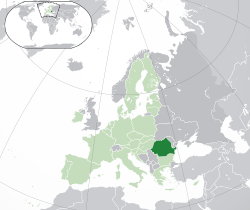
Romania
Country in Eastern and Southeast Europe / From Wikipedia, the free encyclopedia
Dear Wikiwand AI, let's keep it short by simply answering these key questions:
Can you list the top facts and stats about Romania?
Summarize this article for a 10 years old
Romania (/roʊˈmeɪniə/ ⓘ roh-MAY-nee-ə; Romanian: România [romɨˈni.a] ⓘ) is a country in Central, Eastern and Southeast Europe.[14][15] It borders Ukraine to the north, Hungary to the west, Serbia to the southwest, Bulgaria to the south, Moldova to the east, and the Black Sea to the southeast. It has a predominantly temperate-continental climate, and an area of 238,397 km2 (92,046 sq mi), with a population of 19 million people (2023). Romania is the twelfth-largest country in Europe and the sixth-most populous member state of the European Union. Its capital and largest city is Bucharest, followed by Iași, Cluj-Napoca, Timișoara, Constanța, Craiova, Brașov, and Galați.
Romania | |
|---|---|
| Anthem: "Deșteaptă-te, române!" ("Awaken thee, Romanian!") | |
Location of Romania (dark green) – in Europe (green & dark grey) | |
| Capital and largest city | Bucharest 44°25′N 26°06′E |
| Official languages | Romanian[1] |
| Recognised minority languages[2] | |
| Ethnic groups |
|
| Religion |
|
| Demonym(s) | Romanian |
| Government | Unitary semi-presidential republic |
| Klaus Iohannis | |
| Marcel Ciolacu | |
| Legislature | Parliament |
| Senate | |
| Chamber of Deputies | |
| Establishment history | |
| 1330 | |
| 1346 | |
| 24 January 1859 | |
| 9 May 1877/1878 | |
| 1 December 1918/1921 | |
| 1941 | |
| 30 December 1947 | |
| 14 December 1955 | |
| 27 December 1989[5][6][7] | |
| 8 December 1991 | |
| 1 January 2007 | |
| Area | |
• Total | 238,397 km2 (92,046 sq mi)[8] (81st) |
• Water (%) | 3 |
| Population | |
• January 2023 estimate | 19,051,562[9] (63rd) |
• Density | 79.9/km2 (206.9/sq mi) (136th) |
| GDP (PPP) | 2023 estimate |
• Total | |
• Per capita | |
| GDP (nominal) | 2023 estimate |
• Total | |
• Per capita | |
| Gini (2021) | medium |
| HDI (2021) | very high · 53rd |
| Currency | Romanian leu (RON) |
| Time zone | UTC+2 (EET) |
| UTC+3 (EEST) | |
| Date format | dd.mm.yyyy (AD) |
| Driving side | right |
| Calling code | +40 |
| ISO 3166 code | RO |
| Internet TLD | .roa |
| |
Europe's second-longest river, the Danube, rises in Germany's Black Forest and flows southeasterly for 2,857 km (1,775 mi), before emptying into Romania's Danube Delta. The Carpathian Mountains cross Romania from the north to the southwest and include Moldoveanu Peak, at an altitude of 2,544 m (8,346 ft).[16]
Settlement in what is now Romania began in the Lower Paleolithic followed by written records attesting the kingdom of Dacia, its conquest, and subsequent Romanisation by the Roman Empire during late antiquity. The modern Romanian state was formed in 1859 through a personal union of the Danubian Principalities of Moldavia and Wallachia. The new state, officially named Romania since 1866, gained independence from the Ottoman Empire in 1877. During World War I, after declaring its neutrality in 1914, Romania fought together with the Allied Powers from 1916. In the aftermath of the war, Bukovina, Bessarabia, Transylvania, and parts of Banat, Crișana, and Maramureș became part of the Kingdom of Romania.[17] In June–August 1940, as a consequence of the Molotov–Ribbentrop Pact and Second Vienna Award, Romania was compelled to cede Bessarabia and Northern Bukovina to the Soviet Union and Northern Transylvania to Hungary. In November 1940, Romania signed the Tripartite Pact and, consequently, in June 1941 entered World War II on the Axis side, fighting against the Soviet Union until August 1944, when it joined the Allies and recovered Northern Transylvania. Following the war and occupation by the Red Army, Romania became a socialist republic and a member of the Warsaw Pact. After the 1989 Revolution, Romania began a transition towards democracy and a market economy.
Romania is a developed country[18][19][20] and a potential middle power in international affairs.[21][22] It has a high-income economy, being the world's 45th largest by nominal GDP, and the 36th largest by PPP. Its economy ranks as one of the fastest growing economies in the European Union. Romania experienced rapid economic growth in the early 2000s; its economy is now based predominantly on services. It is a producer and net exporter of cars and electric energy through companies like Automobile Dacia and OMV Petrom. The majority of Romania's population are ethnic Romanians and religiously identify themselves as Eastern Orthodox Christians, speaking Romanian, a Romance language (more specifically Eastern Romance/Balkan Romance). Romania is a member of the United Nations, the European Union, NATO, the Council of Europe, BSEC and WTO.


.svg/220px-EU-Romania_(orthographic_projection).svg.png)
